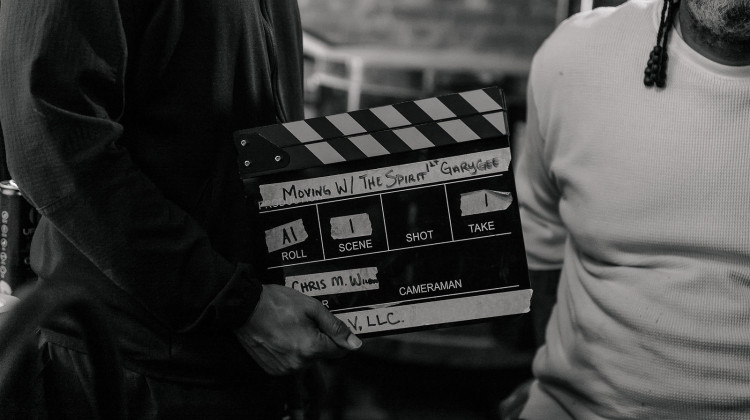
A statue of Hoagy Carmichael seated at a piano is on the Indiana University Bloomington campus near the IU Cinema.
Zach Herndon/WFIUFamed songwriter Hoagy Carmichael was born in Bloomington, Indiana on Nov. 22, 1899. His contributions to jazz music helped put Bloomington on the map.
More than 100 years after his birth, Carmichael is still an integral part of his home town.
WFIU Jazz Director David Brent Johnson explains how Carmichael got started and why his work is still critical today:
What You Should Know About Hoagy Carmichael
Hoagy Carmichael was one of the most successful songwriters to ever come along. And he was really a poet, I think, of the American spirit of the early 20th century and beyond. And he came from Bloomington, Indiana, this little university backwater town in the early 20th century and he wrote songs that went around the world.
There’s this image of Hoagy as this sleepy, laidback guy with a hat tilted back on his head and a cigarette drooping from his mouth, and he did as much as anybody to propagate that image. But behind that he was actually a pretty driven guy who had a fierce energy to him, and that was what I think propelled his song writing. He was very driven, very committed to his craft, very hardworking.
Writing ‘Stardust’
There’s that sign outside the restaurant where the Book Nook used to be on Indiana Ave. that commemorates the part that that particular building played in the formation of what’s really maybe the most famous song in the world.

Sheet music for the Hoagy Carmichael song 'Stardust,' which was at least partially composed at The Book Nook near the IU Sample Gates. Photo: Zach Herndon
There’s that sign outside the restaurant where the Book Nook used to be on Indiana Ave. that commemorates the part that that particular building played in the formation of what’s quite possibly the most famous song in the world.
Hoagy said about writing Stardust that it came to him one night when he was sitting on what was called the “spooning wall: on Indiana Ave. and he was close to a place called The Book Nook and it was closed, it was very late at night, but he said that this melody just came to him and he had to get it down, he had to play it out on the piano and write it down.
So he ran across the street and frantically banged on the door of The Book Nook and managed to implore the owner to open it back up for him so he could go in there and work this melody out on the piano.
Now, some musical scholars have constructed that he actually wrote the whole piece over a longer stretch of time. But it’s not implausible that this part of it actually happened. The owner of The Book Nook talked about it in an interview many years later, so there probably is some truth that at least part of the song did come to him in this manner.
Carmichael’s Lasting Impact
‘Stardust’ is one of the most recorded songs in the history of music, and his songs are still played by jazz musicians today, but what he did also goes beyond jazz. In a way Carmichael was one of the first singer-songwriters, as his biographer put it. When you think about people like Elton John and Billy Joel and other performers who played piano and have written their own songs and performed them, Hoagy was their predecessor, a pioneer at that sort of thing.
Hoagy is buried here out at Rose Hill Cemetery on the west side of Bloomiington. And if you go out there and visit his gravesite, it’s just a very simple grave stone, it says ‘Carmichael’ on it. And usually there will be pennies and other coins and little liquor bottles left on the gravestone by people that have come there to pay tribute to Hoagy.
How Indiana Shaped Carmichael’s Music
You know he lived in California from 1936 to the end of his life, after moving out there to write songs for the movies. But I think what Hoagy always missed was his youth here in Bloomington. I think he was very nostalgic for the time when he was here playing jazz with his friends and living the campus life of the early 1920s, a time when the Jazz Age culture definitely existed in Bloomington.
He left Bloomington and Indiana for good at the end of the 1920s, around the time he turned 30, but I think Indiana stayed in his sound for the rest of his life. This is the place that formed him, that shaped him, and you can really hear that in his music. It evokes something of the Midwest, then and I think even now.
 DONATE
DONATE








 Support WFYI. We can't do it without you.
Support WFYI. We can't do it without you.